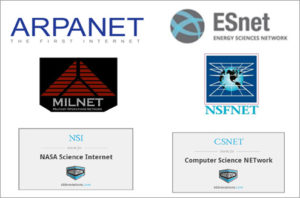
Date: 01/01/1983After the ARPANET had been up and running for several years,ARPA looked for another agency to hand off the network to; ARPA’s primary mission was funding cutting edge research and development, not running a communications utility. Eventually, in July 1975, the network had been turned over to the Defense Communications Agency, also part of the Department of Defense. In 1983, the U.S. military portion of the ARPANET was broken off as aseparate network, the MILNET. MILNET subsequently became the unclassified but military-only NIPRNET, in parallel with the SECRET-level SIPRNET and JWICS for TOP SECRET and above. NIPRNET does have controlled security gateways to the public Internet.
The networks based on the ARPANET were government funded and therefore restricted to non commercial uses such as research; unrelated commercial use was strictly forbidden. This initially restricted connections to military sites and universities. During the 1980s, the connections expanded to more educational institutions, and even to a growing number of companies such as Digital Equipment Corporation and Hewlett-Packard, which were participating in research projects or providing services to those who were.
Several other branches of the U.S. government, the National Aeronautics and Space Agency (NASA), the National Science Foundation (NSF), and the Department of Energy (DOE) became heavily involved in Internet research and started development of a successor to ARPANET. In the mid 1980s, all three of these branches developed the first Wide Area Networks based on TCP/IP. NASA developed the NASA Science Network, NSF developed CSNET and DOE evolved the Energy Sciences Network or ESNet.
NASA developed the TCP/IP based NASA Science Network (NSN) in the mid 1980s, connecting space scientists to data and information stored anywhere in the world. In 1989, the DEC net-based Space Physics Analysis Network(SPAN) and the TCP/IP-based NASA Science Network (NSN) were brought together at NASA Ames Research Center creatingthe first multiprotocol wide area network called the NASA Science Internet, or NSI. NSI was established to provide a totally integrated communications infrastructure to the NASA scientific community for the advancement of earth, space and life sciences. As a high-speed, multiprotocol, international network, NSI provided connectivity to over 20,000 scientists across all seven continents.
In 1981 NSF supported the development of the Computer Science Network (CSNET). CSNET connected with ARPANET using TCP/IP, and ranTCP/IP over X.25, but it also supported departments without sophisticated network connections, using automated dial-up mail exchange. Its experience with CSNET lead NSF to use TCP/IP when it created NSFNET, a 56 kbit/s back bone established in 1986, that connected the NSF supported super computing centers and regional research and education networks in the United States. However, use of NSFNET was not limited to supercomputer users and the 56 kbit/s network quickly became overloaded. NSFNET was upgraded to 1.5 Mbit/s in 1988.The existence of NSFNET and the creation of Federal Internet Exchanges (FIXes) allowed the ARPANET to be decommissioned in 1990. NSFNET was expanded and upgraded to 45 Mbit/s in 1991, and was decommissioned in 1995 when it wasreplaced by backbones operated by several commercial Internet Service Providers.